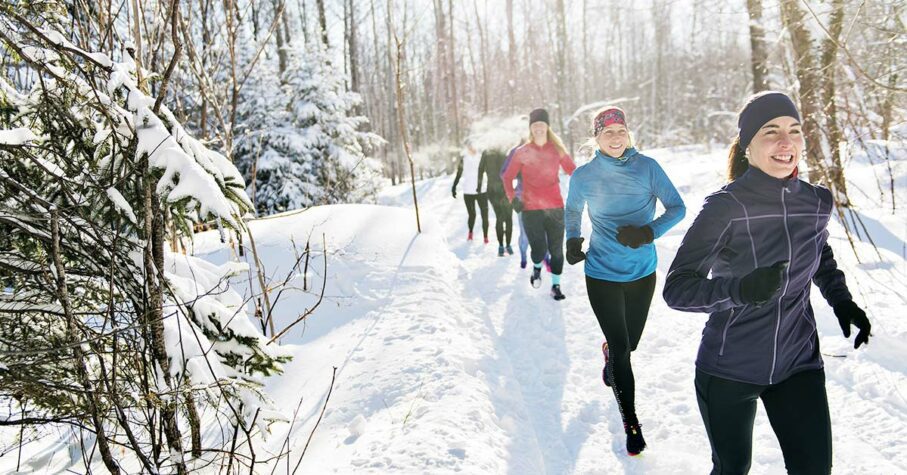
Colder weather drives most active people back to the warmth of the gym, but there are surprising benefits to exercising outdoors in the winter. It improves endurance by enabling you to exercise more efficiently. It transforms body fat into a form the body can use as fuel1. It boosts serotonin levels in the brain, which improves mood and helps fend off Seasonal Affective Disorder2. Exposure to sunlight also helps the body produce the Vitamin D that we tend to run low on during the winter months3.
Preparation is the key to being a successful winter athlete. Here are our top recommendations for staying comfortable and safe while you stay fit.
1 Wear Layers
In the winter, it’s just as important to stay dry as it is to keep warm. A three-layer clothing system is the best way to accomplish both these ends.
- Your base layer (the one you wear next to your skin) should be made of synthetic fibres to wick sweat away from the skin.
- Your middle layer is for insulation, and it should be made of materials that trap the warm air that your body gives off, such as fleece or wool.
- Your outer layer should protect you from wind and rain but also be breathable to keep you comfortable while you’re active.
New fabrics and products are constantly being developed, so check with your favourite sporting goods retailer for the latest offerings and choose items that will work best for the type of exercise you plan to do.
2 Protect Your Extremities
In the cold, blood moves to your core to prevent heat loss, and that means that your hands, feet, and face will get colder, faster. Protect them by wearing a hat or a balaclava, gloves, and warm synthetic or smart wool socks. Some running and cycling shoes are made of porous materials, so get a specialized pair of running shoes for winter and shoe covers for your cycling shoes.
3 Wear Shoes with Good Traction
Ice and snow on the road pose a more significant hazard when you’re on the move. For running, wear shoes that have extra nubs on the soles, such as trail runners or winter running shoes or try the DIY option of attaching traction aids to your footwear. For climbing and hiking, crampons are a good option that you can use with your existing boots and will help improve your stability on slippery snow and ice.
4 Protect Exposed Skin
It’s just as important to take care of your skin in the winter as in the summer: you’re still exposed to sun and wind, and the dry winter air can leave your skin dry and vulnerable to other issues. Before you go out, clean your face thoroughly and let it dry completely. Then apply a hydrating moisturizer and a high SPF sunscreen. Don’t forget to use an SPF balm on your lips, as they can crack in cold weather. Even better, pop a tube of lip balm in the pocket of your jacket for instant relief from harsh winds and cold, dry air.
5 Know the Signs of Hypothermia and Frostbite
Cold air reduces sensation in your skin, so you may not realize when you’re getting too cold. Watch for the signs and symptoms of frostbite: numbness, tingling and pale colouring in the affected areas4. Signs and symptoms of hypothermia include intense shivering, slurred speech, lack of coordination, and drowsiness or fatigue5. Most people with hypothermia don’t realize they have it, so be especially vigilant when the temperatures dip below the 0-degree mark.
Exercising outdoors in the winter may seem arduous and unpleasant at first, but it can be as stimulating as it is beneficial if you’re prepared. Once you get started, you’ll see other people who’ve taken up the challenge, and you’ll feel like you’re part of a pretty great club of fearless winter warriors!
Gear up, and let’s get out there!

SOURCES:
- 1 https://www.health.harvard.edu/staying-healthy/the-wonders-of-winter-workouts
- 2 https://www.washingtonpost.com/lifestyle/wellness/dont-be-afraid-of-the-cold-the-surprising-allure-and-benefits-of-an-outdoor-workout/2014/12/29/e9f01e66-8634-11e4-9534-f79a23c40e6c_story.html
- 3 https://www.health.harvard.edu/staying-healthy/time-for-more-vitamin-d
- 4 https://www.nhs.uk/conditions/frostbite/symptoms/
- 5 https://www.mayoclinic.org/diseases-conditions/hypothermia/symptoms-causes/syc-20352682
BLG604-1221EN







